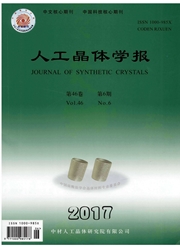

 中文摘要:
中文摘要:
以钛酸正丁酯和无水氯化钙为原料,采用水热法制备了不同紫外光催化特性的Ca Ti2O4(OH)2粉体。利用X射线衍射仪(XRD)和扫描电子显微镜(SEM)对样品的相结构和微观形貌进行了分析,并结合粉体的紫外-可见吸收分光光谱表征了材料的吸收特性及带隙宽度。研究了不同水热反应温度对Ca Ti2O4(OH)2物相结构、微观形貌、晶体生长特性及紫外光催化性能的影响。结果表明:水热反应温度控制在160~200℃时,保温36 h都能得到纯的Ca Ti2O4(OH)2相,粉体的形貌随着水热反应温度的提高经历了由片状和颗粒垛堆到发育成完整的片状形貌过程,当水热反应温度在200℃时,片与片之间出现积聚现象;在水热反应温度为180℃时,制备的粉体具有最高的结晶度,在紫外光5 h下对罗丹明B的催化效率最佳。
 英文摘要:
英文摘要:
CaTi2O4 (OH)2 powders with different ultraviolet photocatalytic properties were prepared by hydrothermal method using n-butyl titanate and anhydrous calcium chloride as raw materials. The phase structure, micro-morphologies, optical absorption properties and band gap width of as-prepared powders were characterized by X-Ray Diffraction( XRD), Field Emission Scanning Electron Microscope( FESEM ) and UV-Vis absorption spectra (UV-Vis). The influence of different hydrothermal temperature on the phase structure, microstructure, crystal growth characteristics and ultraviolet photocatalytic properties of CaTi2O4 (OH)2 were investigated. The results show that the pure CaTi2O4(OH) 2 phase can be obtained at 160-200 ℃ for 36 h. The morphology of the powder from the sheet and pellet stack to develop into a complete sheet morphology process with the hydrothermal reaction temperature improved, and when the hydrothermal reaction temperature at 200 ℃, it can be found the film accumulation. The powder has the highest crystallinity when the temperature is 180℃, and the photocatalytic efficiency of rhodamine B is the best under UV-visible light for 5 h.
 同期刊论文项目
同期刊论文项目
 同项目期刊论文
同项目期刊论文
 期刊信息
期刊信息
